Introduction
In the contemporary landscape of digital communication, Microsoft Teams has emerged as a pivotal tool for organizations seeking to enhance collaboration and streamline workflows. However, the journey to successful implementation extends beyond mere adoption; it necessitates a strategic approach tailored to the unique needs and objectives of each organization. This article delves into the essential steps for:
- Identifying specific requirements
- Selecting qualified experts
- Defining project scopes
- Fostering effective onboarding and training
By establishing a robust framework for monitoring and evaluating success, organizations can maximize the potential of Microsoft Teams, ultimately driving productivity and engagement across teams.
Identifying Your Microsoft Teams Needs and Goals
To effectively assess the specific features of the collaboration platform that your organization requires, consulting with Microsoft Teams experts and conducting a thorough internal evaluation is essential. This process can be broken down into the following key steps:
-
Define Business Objectives: Clearly articulate how the expertise of Microsoft Teams experts can align with and support your overarching business goals.
Consider objectives such as enhancing collaboration, improving communication channels, or streamlining workflows to increase operational efficiency. The significant rise in Stream videos, which increased over fivefold in March 2020, underscores the growing reliance on video communication tools, reinforcing the need for robust functionalities within Teams. -
Engage Stakeholders: It is crucial to involve team members from various departments to obtain a comprehensive understanding of their needs and challenges related to collaboration tools.
Engaging a diverse group, including Microsoft Teams experts, will ensure that the selected functionalities meet the full spectrum of organizational requirements. -
Identify Key Features: Compile a list of essential characteristics that your organization requires from the collaboration platform.
This may include capabilities such as chat, video conferencing, file sharing, and seamless integration with existing tools, which are critical for maximizing productivity for Microsoft Teams experts.
With approximately 27.4 million downloads of the collaboration application in Europe, the Middle East, and Africa between Q1 2020 and Q4 2023, it is clear that this platform is widely embraced, confirming its significance in the present market. -
Set Measurable Goals: Establish clear, quantifiable outcomes that you expect to accomplish through the use of the collaboration platform.
Examples could include reducing email volume, improving project turnaround times, or enhancing team responsiveness.
Setting measurable goals will facilitate the evaluation of success post-implementation. -
Create a Budget: Evaluate your financial limitations for employing specialists who can aid in the execution of the collaboration platform.
Comprehending your financial criteria from the outset will assist in simplifying the choice of consulting services that most closely align with your organization's requirements.
By adhering to these organized steps, you will formulate a thorough outline of your organization’s needs and goals, establishing a strategic plan that will direct your recruitment process and guarantee a successful incorporation of the platform. Furthermore, the case study showing that YouTube was the top social media referrer to teams.microsoft.com, accounting for 23.85% of total traffic, emphasizes the significance of external platforms in boosting usage, further reinforcing the necessity for effective evaluation of functionalities.
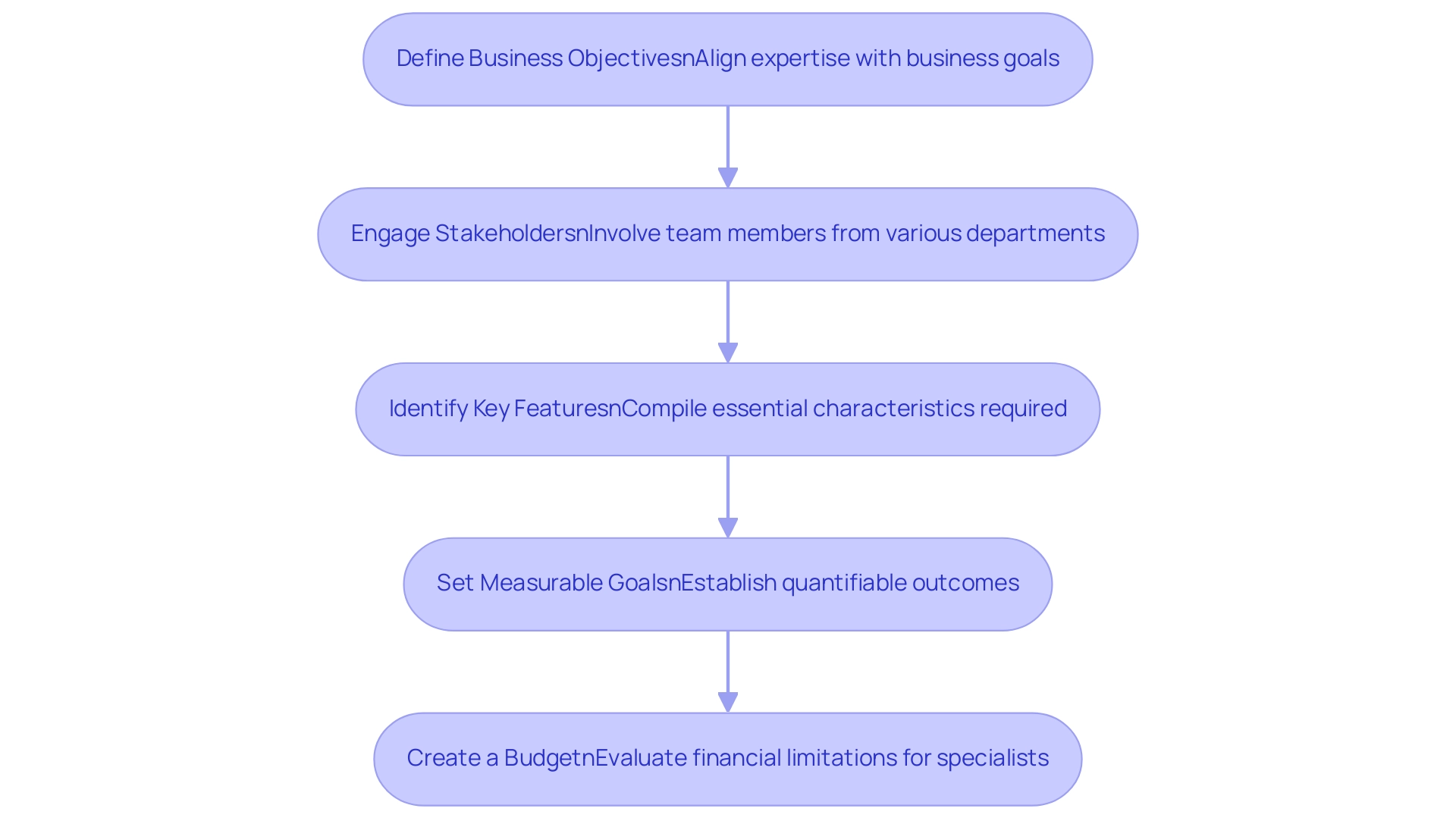
Evaluating and Selecting the Right Microsoft Teams Experts
To effectively evaluate and select the right Microsoft Teams experts for your organization, follow these structured steps:
-
Develop Evaluation Criteria: Create a detailed checklist that encompasses key qualifications, experience with collaborative platforms, and knowledge of your particular industry. This foundational step ensures that candidates meet the necessary standards for your unique needs, as evaluated by Microsoft Teams experts.
-
Source Candidates: Leverage professional networks, online platforms, and trusted referrals to identify potential experts. Collaborating with partners can offer valuable suggestions, improving your candidate pool.
-
Conduct Interviews: Arrange for in-depth interviews to discuss candidates' experiences in implementing collaboration solutions. Inquire about particular initiatives they have overseen and the results obtained; as one client noted, "STS Consulting Group was the missing piece to my puzzle." From start to finish, they solved every problem and helped us achieve our goals in the most professional way possible.
-
Request Case Studies: Solicit candidates to present case studies or examples of previous work that showcase their problem-solving skills and depth of knowledge. This not only highlights their capabilities but also offers insight into their approach to challenges. For instance, the Royal Free London NHS Foundation Trust rapidly implemented Microsoft Teams during COVID-19, achieving over 500 daily active users within 11 days, which demonstrates the effectiveness of Microsoft Teams experts in crisis situations.
-
Check References: Reach out to former clients to gain a clearer picture of candidates' performance, reliability, and ability to meet deadlines. This step is crucial for validating claims made during the interview process. As another client remarked, "Using STS Consulting Group helped me save weeks of work. Their delightful level of quality and service is consistent and one of a kind. I can't recommend STS Consulting Group enough."
-
Evaluate Cultural Fit: Assess how well candidates align with your organization’s culture and values. A strong cultural fit is vital for fostering collaboration and ensuring project success.
-
Make an Informed Decision: After careful evaluation, choose the expert or team that aligns most closely with your operational goals and strategic vision. This decision should reflect a thorough understanding of how the selected consultant can facilitate your organization’s collaboration initiatives.
Incorporating client testimonials can significantly bolster your evaluation process. Here are some endorsements that reflect the effectiveness of STS Consulting Group:
- "I was really impressed with the way STS Consulting Group handled everything. From the first conversation to everything in between, they were very helpful and knowledgeable."
- "Using STS Consulting Group helped me save weeks of work. Their delightful level of quality and service is consistent and one of a kind. I can't recommend STS Consulting Group enough."
As Naveen Kumar states, "With a strong foundation in data analysis, he focuses on transforming complex statistics into actionable insights for readers across diverse industries." By following this organized assessment procedure and recognizing that 8 million businesses in the US utilize the platform, you can confidently recruit Microsoft Teams experts who will significantly enhance your organization’s collaborative abilities, ensuring their contributions are both impactful and aligned with your strategic goals.
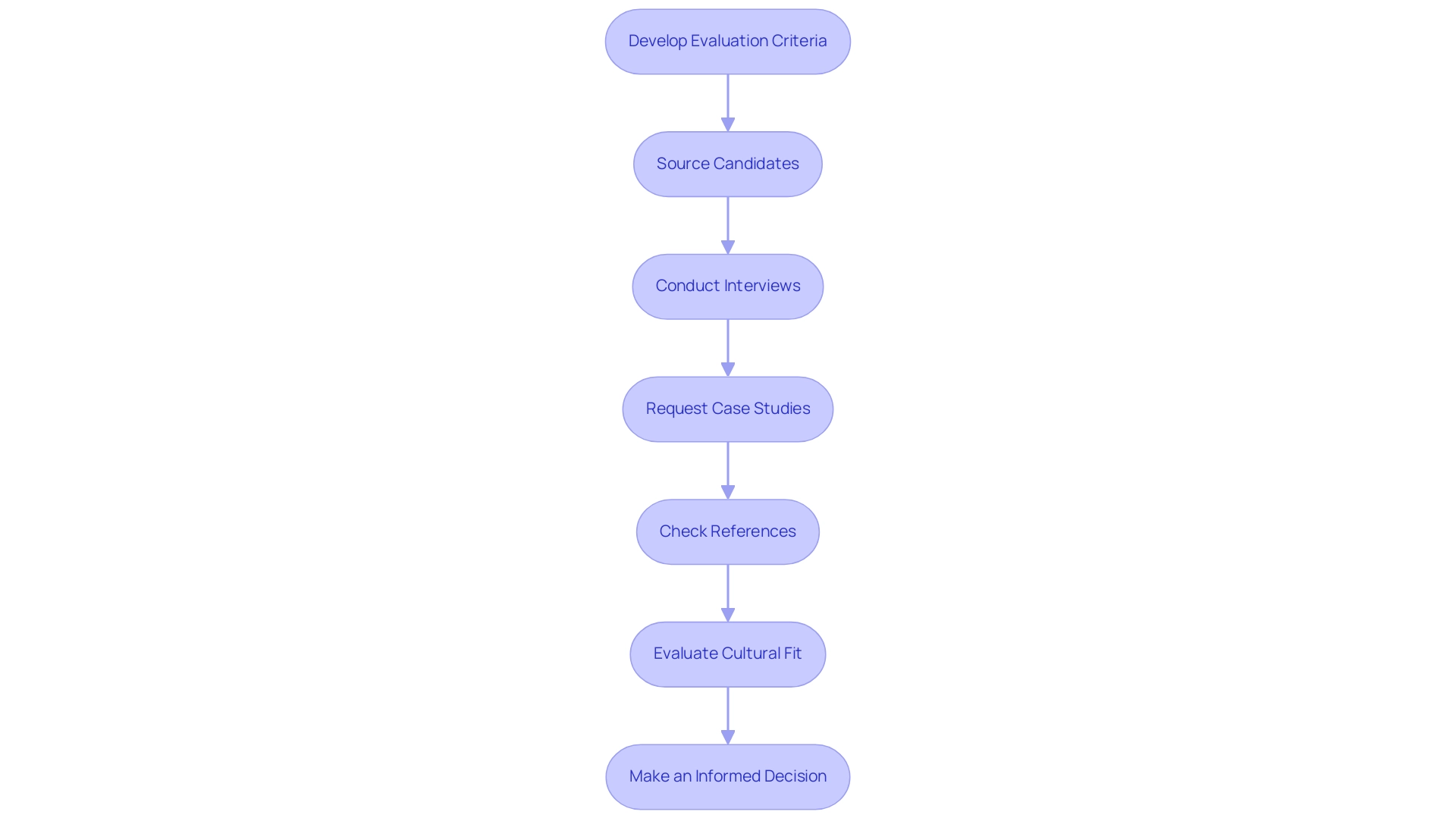
Defining the Scope of Work
Once you have chosen your Microsoft Teams experts, defining the scope of work becomes a pivotal step in ensuring success. This process encompasses several key components:
-
Drafting a Detailed Plan: Create a comprehensive outline of key tasks, timelines, and milestones that will serve as the roadmap. This plan should specify implementation phases and critical deadlines, reflecting the structured approach favored by over 53% of teams utilizing the Safe methodology. Significantly, Agile methods are employed by 87% of business analysts, highlighting the importance of these methodologies in management for collaborative environments.
-
Identifying Deliverables: Clearly articulate the expected deliverables from your Microsoft Teams experts, which may include documentation, training sessions, and specific configurations. This clarity helps reduce the risk of failure, which is notably attributed to a lack of alignment between business and objectives, as highlighted by industry insights.
-
Establishing Roles and Responsibilities: Assign specific duties for each aspect, delineating tasks among both external experts and your internal personnel. This ensures accountability and enhances team collaboration.
-
Setting Communication Protocols: Define the communication channels and frequency of updates. Establish a regular meeting schedule to discuss progress, address challenges, and realign objectives as necessary. This is increasingly vital as customer and stakeholder expectations evolve.
-
Incorporating Feedback Mechanisms: Develop a systematic approach for ongoing feedback throughout the initiative. This enables prompt modifications to be implemented, ensuring that milestones are met and expectations are consistently aligned.
-
Leveraging Emerging Technologies: Consider the insights from the case study titled "Tech Trends Shaping Management," which highlights how emerging technologies such as AI, machine learning, and data analytics are transforming management practices. Integrating these technologies can enhance efficiency and decision-making, further supporting effective planning and execution.
By meticulously defining the scope of work, you create a robust framework that fosters effective collaboration and significantly enhances the likelihood of achieving objectives, thereby reducing the common failure rate. Additionally, understanding that more than 28% of teams opt for Scrum@Scale can provide further insights into the methodologies that might best suit your project needs.
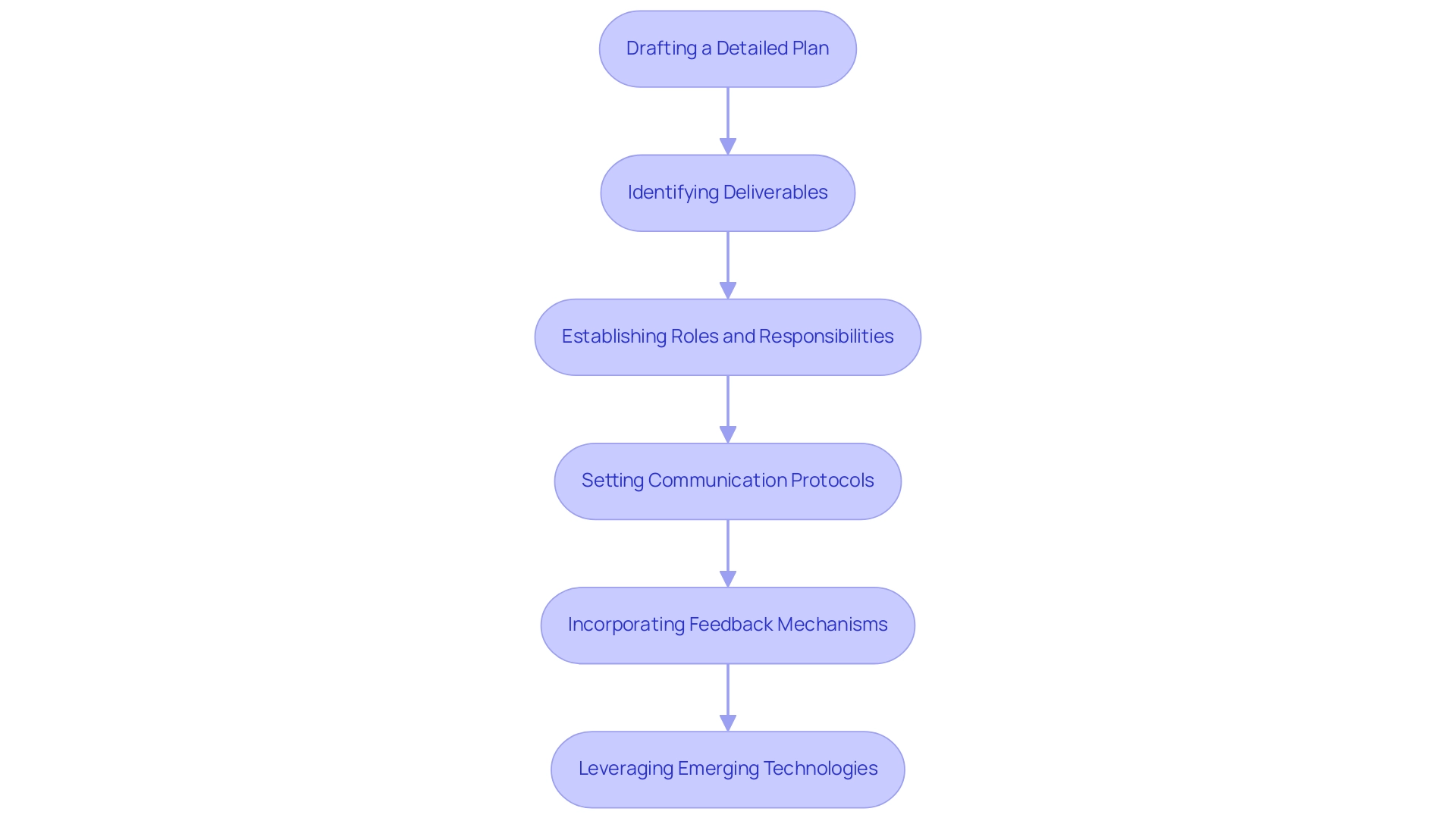
Onboarding and Training
Following the introduction of the collaboration platform, it is essential to focus on onboarding and training to facilitate successful adoption. The following key steps will guide you in this process:
- Develop a Comprehensive Training Program: Create a structured training curriculum that aligns with your organization’s specific needs, covering all essential features of the collaboration platform.
- Utilize Diverse Training Formats: Implement various training methods, including live workshops, recorded webinars, and user manuals, to cater to different learning preferences and ensure inclusivity.
- Encourage Practical Application: Facilitate hands-on practice sessions where group members can interact with the platform in a controlled environment, allowing them to ask questions and seek guidance.
- Designate Champions: Identify and train enthusiastic group members as champions of the platform. These individuals will provide support to their peers and serve as key points of contact for any inquiries.
- Collect and Analyze Feedback: After each training session, gather feedback to assess what was effective and identify areas for improvement. This feedback will be invaluable for refining future training initiatives.
- Ensure Ongoing Support: Establish dedicated channels for continuous assistance, such as a helpdesk or regular Q&A sessions, to aid staff members as they incorporate collaborative tools into their daily workflows.
Focusing on onboarding and training enables your group to use the collaboration platform effectively, especially with the guidance of Microsoft Teams experts, ultimately improving cooperation and productivity. As Alex Fleck highlights, "The journey ahead for the group involves assisting employees in incorporating business processes into the hub at deeper levels to experience even more of the extensibility and productivity benefits that the platform provides." This commitment to training will facilitate a seamless transition and foster a culture of collaboration within your organization.
Furthermore, considering the historical context, Burwood Group adopted VoIP in 1997, emphasizing the progress of communication technologies and the need to adjust to new resources such as alternative collaboration platforms. The incorporation of the collaboration platform, as shown by the case study titled 'Shift in Workplace Communication,' illustrates its transformative effect on workplace interaction, motivating users to depend on real-time discussions and file sharing instead of conventional email. This change highlights the significance of efficient training to guarantee that your group can fully utilize the functionalities of the collaboration platform with the assistance of Microsoft Teams experts.
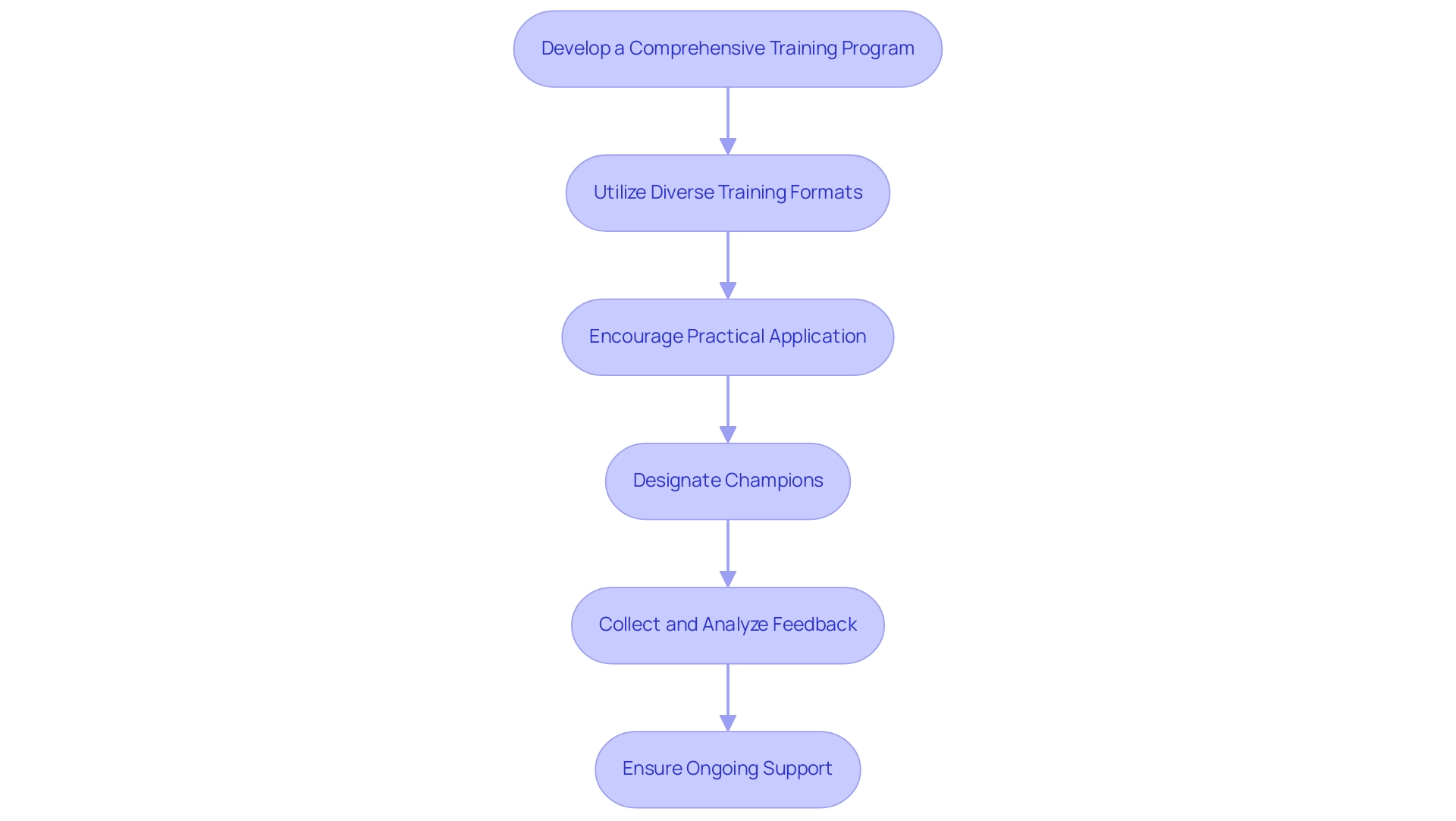
Monitoring and Evaluating Success
To ensure the success of your collaboration platform implementation and its ongoing alignment with organizational needs, it is critical to follow these structured steps:
-
Define Key Performance Indicators (KPIs): Begin by establishing KPIs that are directly aligned with the objectives identified during the initial needs assessment. Important KPIs to consider include user adoption rates, frequency of platform usage, and quantifiable improvements in collaboration metrics.
-
Regularly Review Usage Data: Utilize platform analytics to gain insights into how frequently and effectively it is being utilized. Monitor trends and patterns to pinpoint areas that may require enhancement, especially considering that 41% of respondents in a 2022 survey reported spending between 4 and 8 hours troubleshooting performance issues. Utilizing tools like OfficeExpert TrueDEM can facilitate faster root cause analysis and proactive remediation for chronic problems, ultimately leading to improved performance.
-
Conduct User Surveys: Gather input from team members about their experiences with the platform through user surveys. This feedback is invaluable for identifying challenges and determining where additional training or resources may be necessary to enhance user experience.
-
Hold Review Meetings: Organize regular review meetings with key stakeholders to discuss insights derived from usage data and user feedback. This collaborative approach fosters a culture of continuous improvement and enables the identification of opportunities for enhancement. For instance, the case study on Cloud Network and Data Center Performance highlights how gathering metrics related to service uptime and processing times can provide transparency and enable accurate end-to-end call quality analytics for Teams.
-
Adjust Strategies as Needed: Stay agile by making necessary adjustments to your strategies based on evaluation findings. This could involve refining training programs, shifting the scope of work, or enhancing platform features in response to user feedback. As Karl Sand, a marketing expert with extensive experience in the technology environment, suggests,
Get a free trial of Office Expert TrueDEM to gain real-time insight into your organization’s collaboration platform usage, performance, and experience, and understand what to do to enhance. This tool can help organizations optimize employee hardware and home network provisioning, ensuring a smoother user experience. By actively monitoring and evaluating the success of your Microsoft Teams implementation with the help of Microsoft Teams experts, you will ensure that it continues to deliver significant value and effectively support your organization’s evolving collaboration needs.
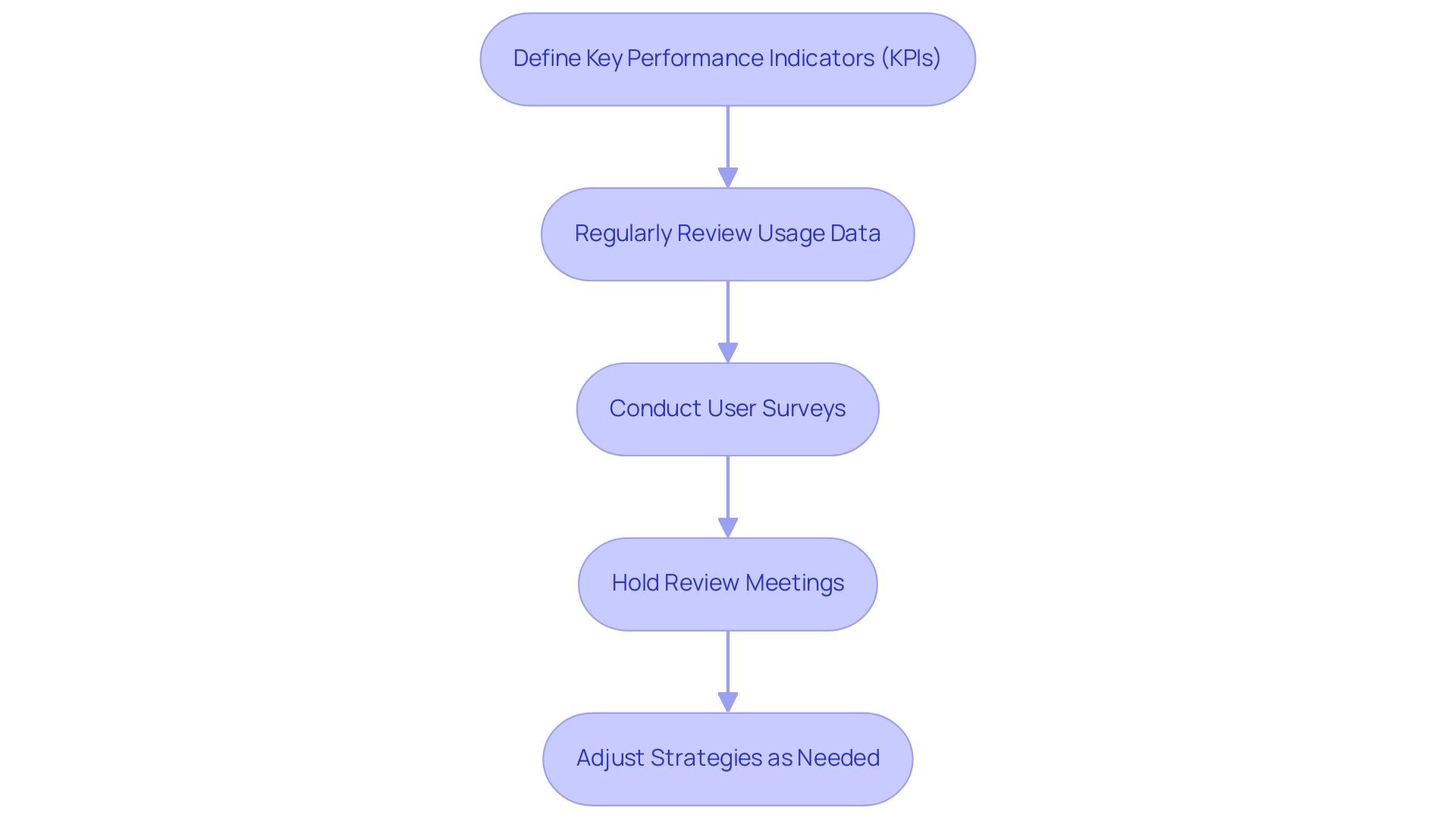
Conclusion
The successful implementation of Microsoft Teams relies on a strategic approach that includes several key steps. Organizations should start by identifying their specific needs and objectives, ensuring that the selected functionalities align with overall business goals. Engaging stakeholders from various departments provides valuable insights into collaboration challenges and helps pinpoint essential features for enhancing productivity.
Selecting qualified experts is crucial, as their experience and cultural fit can significantly impact the implementation's success. Establishing clear evaluation criteria and conducting thorough interviews ensures that chosen consultants have the necessary skills and align with the organization's values. This preparation lays the groundwork for a well-defined scope of work, including a detailed project plan and established communication protocols.
Once Microsoft Teams is implemented, a strong focus on onboarding and training is necessary to drive user adoption. A comprehensive training program that accommodates diverse learning styles and encourages hands-on practice will empower team members to utilize the platform effectively. Continuous support and feedback mechanisms are essential for refining training initiatives and ensuring ongoing proficiency.
Finally, organizations must create a framework for monitoring and evaluating success. By defining key performance indicators, regularly reviewing usage data, and gathering user feedback, organizations can identify areas for improvement and adapt strategies accordingly. This iterative approach maximizes the potential of Microsoft Teams and fosters a culture of collaboration.
By committing to these essential steps, organizations can fully leverage Microsoft Teams to enhance collaboration, streamline workflows, and achieve sustained success.




